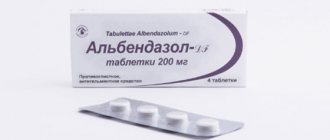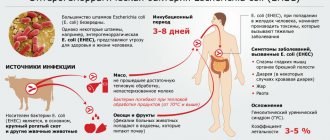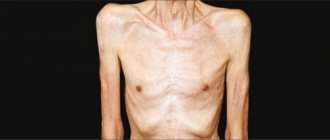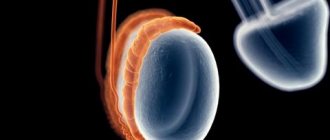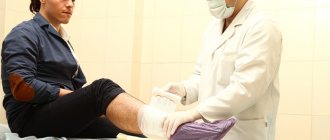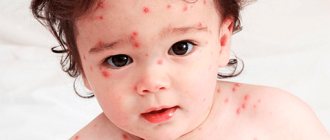Is it dangerous to health and how is effective treatment carried out?
The site provides reference information. Adequate diagnosis and treatment of the disease is possible under the supervision of a conscientious doctor. Any medications have contraindications. Consultation with a specialist is required, as well as detailed study of the instructions! Here you can make an appointment with a doctor.
What is microsporia of smooth skin
Microsporia is an inflammation of certain areas of the skin, hair, and rarely nails, caused by a pathogenic fungus of the genus Microsporium (more than 20 of its varieties are known).
This lesion is often diagnosed in pediatric practice. Children get sick between the ages of 6 and 14 years.
Among adults, this pathology is registered in 9-25% of cases annually. Recently, there has been an increase in the number of reports of the identification of foci of infection in families affecting adults and the elderly.
Find the answer
Are you having any problem? Enter “Symptom” or “Name of the disease” into the form, press Enter and you will find out all the treatment for this problem or disease.
Microsporia is a common disease; it ranks second among fungal diseases after mycosis of the feet.
In the last decade, there has been a trend towards a decrease in microsporia of the scalp and an increase in the number of mycoses of smooth skin with additional inflammation of vellus hair - microsporia of smooth skin.
The causative agents of the disease and how long the incubation period lasts
The main causative agents of microsporia in humans are:
- The zoophilic fungus Microsporium canis - about 98% in the European part of Russia - is transmitted to humans from a sick animal;
- The anthropophilic fungus Microsporium ferrugineum – about 1% – is transmitted from person to person;
- In the territories of Siberia and the Far East, on the contrary, the pathogen Microsporium ferrugineum is more widespread.
The incubation period is the time from the first contact of the fungus with the skin until the onset of clinical manifestations of the disease.
The duration of this period for microsporia is: 7 days in the case of a zoonotic infection caused by Microsporium canis. In anthroponosis – caused by Microsporium ferrugineum – longer, about 45 days.
Prevalence in nature
The fungi that cause the disease are ubiquitous. Favorable conditions for their life are created in regions with a warm, humid climate.
Zoophilic, anthropophilic, and geophilic Microsporum fungi are found in nature; almost all types are dangerous to humans.
Geophilic fungi live in the soil; infection occurs when working with soil in summer cottages. Anthropophilic fungi are found on human skin.
Zoophilic fungi are spread by animals. Homeless animals pose a danger of microsporia infection to humans.
The zoophilic fungus Microsporum canis, which parasitizes mainly cats, has recently become almost the only cause of microsporia in humans, for which it has received the name cosmopolitan fungus.
Quarantine for pathology
After identifying a sick person, you must:
- Isolate the patient from others (the child does not attend kindergarten or school);
- Disinfect clothing, work or study areas;
- Provide the patient with individual care products (soap, comb), bed linen for an infected person and thoroughly treat them daily (boiling water, washing, ironing, etc.);
- Examine relatives, employees, and classmates who were in contact with the patient;
- If you have pets, examine and treat them;
- Start antifungal treatment.
There are no clear standards for the duration of quarantine for microsporia.
- With a common form of microsporia (3 or more lesions on the skin, inflammation of vellus hair), after 1-2 smears that do not contain fungus, quarantine for the patient can be completed. This occurs approximately 2-4 weeks of treatment. The timing may be changed by the treating dermatologist.
- In mild cases of the disease - 1-2 small spots under clothing - you can limit yourself to exemption from physical education, visiting the pool, sports sections, provided that the necessary therapeutic and hygienic measures are carefully followed.
Risk factors
Children who experience the environment through tactile contact, from animals, touching grass, or touching other people's toys are especially often infected with microsporia. Factors contributing to the occurrence of the disease are:
- Decrease in the body's defenses.
- Prolonged contact with an unhealthy animal.
- Presence of wounds on the skin.
- Failure to comply with personal hygiene requirements.
The disease is also seasonal, most often occurring in the autumn months and decreasing with the arrival of spring.
Reasons for the spread of the disease
The reservoir of zoophilic microsporosis for humans is:
- Sick cats, especially kittens (70-80%);
- Dogs - much less often;
- In 4-5% of cases, small rodents (rabbits).
The main source of infection is mainly kittens, because, on the one hand, they are more susceptible to the disease due to their undeveloped immunity and developed undercoat, which is the basis for the proliferation of the fungus.
On the other hand, they are highly attractive to a child as a living toy.
Infection of children and adults with a fungus of the Microsporium canis type occurs:
- By direct contact with an affected animal;
- Or indirectly - through surfaces contaminated with its fur;
- Transmission of zoophilic fungus between people may occur rarely (2-10%).
At home, the cause of infection will be:
- Towels, bed linen;
- Hats, clothing;
- Toys;
- Carpets, upholstered furniture;
- Dust, sand of staircases;
- Animal rugs and care products.
The cause of infection in newborns can be a stroller left in the entrance at night, which is visited by cats.
In hairdressing salons:
- Towels, scissors;
- Haircut and shaving equipment;
- Peignoirs.
In kindergartens and schools:
- Towels;
- Toys;
- Clothing, hats;
- Books.
The level of infection by a fungus such as Microsporium canis varies throughout the year:
- The beginning of the increase in incidence is recorded in June.
- Growth occurs towards the end of summer and beginning of autumn.
- The maximum number of cases is often detected in October–November.
- Then there is a decline in the disease with a minimum in April.
The wavy curve is associated with the development cycle of the fungus in kittens and increased communication between children and animals in spring and summer - during the holidays (trips to dachas, villages, health and sports camps).
The increase in diseases in the autumn is explained by the return of children to the city from health camps, when they are carefully examined by their parents and routine medical examinations are carried out before visiting kindergartens and schools.
The source of anthropophilic microsporia is infected people. This microsporia is more contagious than zoophilic. Previously, when it was widespread, outbreaks of this disease were recorded in boarding schools, kindergartens, schools, orphanages, and summer camps.
Prevention
Prevention of microsporia comes down to three simple measures:
- Maintaining hygiene rules when caring for pets. Buy cats and dogs that have successfully passed a veterinary examination. Have pets living in the house periodically examined at a veterinary clinic so that a specialist can confirm the absence of diseases dangerous to the owner. Make sure that children do not kiss their pets or touch their litter box. Teach all family members to wash their hands after handling animals. Prohibit children from playing with homeless people.
- Timely diagnosis and isolation of the patient. Considering that children interact closely in kindergartens and other groups, it is important to prevent the transmission of microsporia between their visitors. Place a child sick with microsporia in home quarantine and, if possible, notify the parents of other children about the situation. Get yourself examined and ask other family members to visit a dermatologist.
- Disinfection of the patient's belongings. Any personal belongings of the patient must be disinfected. Clothes and bedding are washed with regular powder in water at a temperature of 60°C. Household items, if this does not spoil them, are boiled in a basin or pan for 15 minutes. If things cannot tolerate boiling water, they are treated with a special antifungal agent Terralin. Everything is subject to treatment - combs, dishes, towels, furniture and even shelves in the closet where the things of an adult or child with microsporia are stored.
Microsporia is a dangerous disease, and no one is immune from it. However, with timely access to the clinic and systematic treatment, doctors give a favorable prognosis for ringworm.
Strengthen your immune system and keep your body clean and your pets healthy. This will make the risk of microsporia infection minimal.
Clinical manifestations of damage to the head and other parts of the body
Conventionally, there are several types of “ringworm”:
- Damage to the scalp;
- Foci of inflammation on the skin of the limbs and torso;
- Mixed form.
In recent years, the number of atypical forms of this disease has increased, which complicate diagnosis and delay prevention and effective treatment.
Skin manifestations of microsporia:
- First, spots or papules (primary elements) appear on a piece of skin infected with a fungus.
- Then crusts appear (secondary elements of “lichen”).
More often, elements of inflammation occur at the site of contact with an infected animal:
- Face;
- Neck;
- Hands.
Much less often lesions appear on the skin:
- Shins;
- Stop;
- Sometimes on the genitals.
What does inflammation look like in zoonotic species?
Microsporium canis tends to produce many small lesions tending to merge. The dimensions of these zones are about 1-2 cm. Eyelashes and eyebrows are often involved in inflammation.
In 80-90%, vellus hair also shows signs of inflammation, which indicates the severity of the disease.
From time to time, with this form, microsporids are detected - nodules that form with concomitant allergies. Sometimes the body temperature rises and the general condition of the person is disturbed.
Zoonotic microsporia is not characterized by a chronic course.
Description of foci of inflammation in anthropogenic microsporia
When affected by a fungus such as Microsporium ferrugineum, foci of inflammation are formed from a large number of small papules, which subsequently form a marginal border.
With a significant exudative component, papules alternate with vesicles - vesicles.
The exudate later organizes into crusts. The raised edge of the inflammatory focus consists of dried elements. In the center of the spot, inflammation can end as a result of the resorption of part of the fungus, and then begin again.
This is how the typical symptoms of this disease are formed - a ring in a ring. The spots on the skin are usually pale pink in color and moderately flaky.
They are often located in the form of a hyperemic border of inflammation at the junction of the scalp with the smooth skin of the neck and face. Due to the ability of neighboring elements to combine, these lesions are sometimes large and uneven in outline.
Unfused zones are often small in size and round in shape.
Inflammatory changes and peeling when affected by the fungus Microsporium ferrugineum are less pronounced than when affected by Microsporium canis.
Most infected vellus hairs in the area of inflammation do not have a sheath and do not break off.
This form is prone to chronicity.
Symptoms
If skin microsporia develops, the sick child needs to be examined at the first appearance of symptoms. The parents' gaze immediately stops at the rashes, which are localized on visible parts of the body - arms, legs, neck, abdomen, forearms, and affect the facial and scalp. Other symptoms of microsporia that can be diagnosed on smooth skin at home are also presented below:
- the appearance of round red spots on the body;
- the presence of a pronounced border of the pathology focus;
- hyperemia and swelling of the dermis;
- formation of a roller consisting of bubbles, crusts, nodules;
- pale skin;
- characteristic seals on skin scales;
- gradual increase in foci of pathology.
In children
If a child pets a street cat, it is possible that a few days later the parents will be alarmed by the appearance of red spots on their palms or other parts of the body. This is ringworm, the outbreaks of which depend on the area of contact of smooth skin with spores of pathogenic fungi. In addition to the abnormal round spot, which is accompanied by itching, microsporia is characterized by the following unpleasant symptoms:
- elevation of foci of pathology above smooth skin;
- the presence of a rim made of small crusts;
- increased swelling of the peeling area;
- visible inflammation of smooth skin;
- impaired patency in the endocrine glands.
Effective treatment for this disease
The main types of treatment for microsporia are:
- Local - the use of antifungal ointments and creams, removal of infected hair, many recipes for treatment with “traditional medicine”;
- Systemic – taking antifungal drugs orally;
- Sanitary and hygienic measures to limit the spread of infection.
Treatment of mild forms of the disease
The presence of single inflammatory areas on the skin (no more than 3 lesions) indicates a mild course. Treatment can only be external, in the form of antifungal ointments and hair removal.
External treatment:
- The locally infected area is lubricated with antifungal ointment daily for about 2 months;
- Epilation or shaving is carried out in areas of inflammation on the skin to mechanically remove the fungus, once every 5 days.
During therapy, scrapings from the lesion are performed once a week to monitor the quality of the therapy (the absence of fungus in 2-3 scrapings from the affected areas confirms a good effect of treatment).
Treatment of common forms of the disease
In the common form of “lichen,” more than 3 foci of inflammation and/or simultaneous inflammation of vellus hair at the site of the lesion are found on smooth skin. Such patients are prescribed combination therapy.
Its principle is to:
- Internal antifungal drugs;
- External treatment.
Any treatment is always carried out in conjunction with sanitary measures:
- Identification of the source of infection and its sanitation;
- Examination of those in contact with the sick person;
- Compliance with sanitary measures in the patient’s family (wet cleaning of the room, disinfection of the patient’s individual linen.).
Diagnostics
Before starting to use antifungal drugs, doctors prescribe diagnostics, which necessarily include the use of a Wood's lamp and histological examination of the mycelium. In the first case, luminescent radiation is used to illuminate the focus of the pathology, in the second, a sample of the focus of pathology is taken for further interaction with the Sabouraud nutrient medium. After conducting microscopic examinations, the doctor recommends conservative treatment with antibiotics.
The most reliable medications
The main antifungal agents for ringworm are:
- Griseofulvin, it can be used now, if it is available in the retail chain;
- Terbinofen;
- Intraconazole;
- Fluconazole.
Griseofulvin is synthesized by a number of fungi of the genus Penicillium.
Available in the following forms:
- Tablets of 500 and 125 mg (- microionized and ultraionized - to improve absorption);
- Suspension – 0.1 g in 1 ml of griseofulvin.
Children under 13 years of age are prescribed 22 mg/kg of griseofulvin per day, in 2-3 doses.
Take the medicine with food, adding a teaspoon of vegetable oil to improve the dissolution of the drug and increase its duration of action.
For young children - a suspension, 8 ml of which corresponds to 125 mg per tablet.
There are extended forms of this drug for a single dose.
The average duration of treatment is 8-12 weeks.
The next most commonly prescribed drug is terbinofen. Trade names: exifin, lamisil, terbizil.
Internally prescribed:
Children over 2 years old:
- Up to 20 kg – 62.5 mg;
- 20 – 40 kg – 125 mg;
- More than 40 kg – 250 mg.
Adults – 250 mg 1 time per day.
The duration of taking the drug is 8-12 weeks.
Intraconazole is a triazole derivative. Not recommended for use in children under 12 years of age.
Dosage regimen:
- 100 mg/day for children weighing up to 25 kg;
- 200 mg/day for children weighing over 25 kg in 2 divided doses.
The duration of treatment for “lichen” is about 6 weeks.
All antifungal drugs are toxic. Only a doctor should prescribe treatment.
Fluconazole is often prescribed topically (ointments, shampoos, creams, solutions).
Externally apply 1% exifin once a day – 2 months.
The use of local agents with an irritating effect (iodine, sulfur) to treat ringworm leads to an increase in residual cosmetic effects and is often not effective enough. Therefore, they can be prescribed only if the effect of more gentle methods (the use of local antifungal ointments) is poor.
Routes of infection
Effective treatment of microsporia in children is complicated, so the first step is to determine in the laboratory (under a microscope) the nature of the pathogenic pathogen. In addition, it is urgent to find out how the infection occurred. The routes of infection may be:
- contact and household;
- airborne;
- nutritional.
Help from folk remedies
Microsporia is popularly called “ringworm.” There are many ways to treat this disease, which use juices and tinctures of vegetables, decoctions of herbs with antifungal properties, and healing ointments.
We list several recipes and substances used to treat “lichen” by non-medical methods.
Apply the juice squeezed from onions to the source of the disease.
Hungarian garlic vinegar recipe
- Peel 3 cloves of garlic and add apple cider vinegar (600 ml).
- They insist for 14 days.
- Treat the skin lesions with the prepared tincture.
Use compresses, baths and lotions from decoctions and tinctures of medicinal herbs:
- Wormwood;
- Celandine;
- Tansy.
Preparation of an effective ointment
Burnt sulfur ointment:
- Choose a base for the ointment: duck or goose fat, lanolin or petroleum jelly, or boric ointment.
- Powdered sulfur is combined with the selected base and brought to the state of thick sour cream.
The candied honey is combined with a small amount of fish oil, stirring until the mixture reaches a thick consistency.
Preparation of boric acid solution
- Dissolve a teaspoon of acid in half a glass of water.
- The solution is heated over a fire until the crystals completely disappear, then cooled.
- The prepared product is used to treat the affected areas.
Preparing propolis oil
- Grind 20 grams. Bee propolis.
- Combine with 50 gr. Vegetable oil.
- The components are combined and, stirring regularly, brought to a boil in a water bath.
- The mixture is brought to a boil again, the propolis dissolves, and the wax precipitates.
- The oil is carefully poured into a bowl.
- Lubricate areas of inflammation.
In folk medicine, birch tar, solid oil, and kerosene in pure form or in the form of ointments are widely used to treat ringworm.
Therapy only with folk remedies raises doubts about the possibility of achieving final recovery.
Features in children
If you notice signs of ringworm in children, do not panic. If the symptoms are detected on time, then treatment will take from two weeks to a month, the main thing is to do it correctly.
The baby should not be bathed in the bathroom; during water procedures, the lesions are sealed with cellophane and the skin is treated with a damp sponge.
It is better to replace synthetic clothes with cotton ones; linen should be changed more often and treated with a steam iron after washing. Iron the child’s things separately from everyone else, and wear latex gloves when handling ointments and lotions.
The surfaces of sofas and armchairs in the house need to be treated with a hot iron from time to time, toys should be doused with boiling water or chlorine solutions, and the floor should be washed with disinfectants more often.
The doctor recommends the medications in each case. Negative tests performed three times will indicate that the child has recovered.
How can you prevent this disease?
For effective prevention, carry out public and individual measures to limit the spread of infection:
- Catch stray animals and prevent children from interacting with them.
- Have farm animals regularly examined by a veterinarian.
- Destroy mouse-like rodents.
- Regularly conduct medical examinations in children's institutions (to prevent anthroponotic microsporia) and timely isolate sick children from healthy ones.
- Have family members who have been in contact with the infected person examined by a doctor.
- Equip medical institutions with diagnostic devices for microsporia.
- Carry out high-quality final disinfection in areas of microsporia.
- Maintain a hygienic regime in the family where an infected person has been identified.
Doctor: Olga Shishkina ✓ Article checked by doctor
